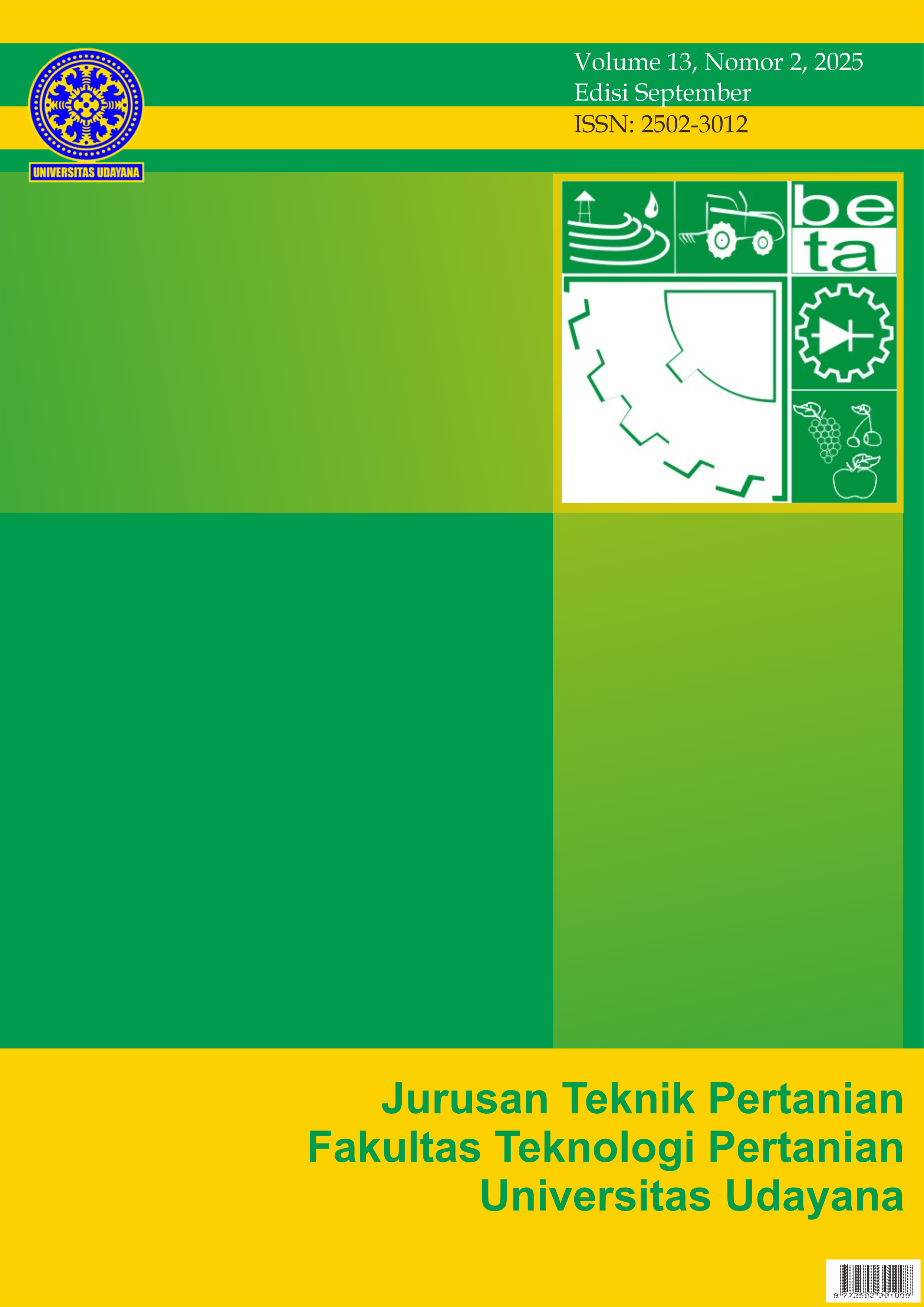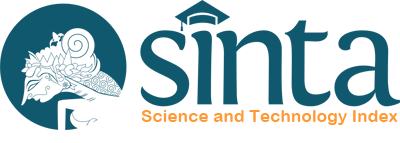Residu Pestisida pada Tanah dan Kotoran Cacing di Lahan Pertanian Sayur Kecamatan Baturiti, Kabupaten Tabanan
Abstract
Abstrak
Pertanian konvensional identik dengan penggunaan agrokimia untuk meningkatkan produksi, namun intensitas pestisida dapat menekan populasi organisme tanah seperti cacing tanah. Penelitian ini bertujuan mengidentifikasi residu pestisida pada tanah dan kotoran cacing di lahan sayur organik dan konvensional di Kecamatan Baturiti, Kabupaten Tabanan, serta menganalisis korelasi sifat tanah dan karakteristik kotoran cacing terhadap residu pestisida. Sampel diambil dengan metode purposive sampling dan minipit (0,5 × 0,5 m), lalu dianalisis menggunakan Gas Chromatography untuk mendeteksi Klorpirifos dan Profenofos. Lahan sayur organik adalah lahan sayur yang tidak menggunakan bahan kimia dan telah tersertifikasi. Parameter tanah meliputi tekstur, berat volume, kadar air, pH, dan C-organik. Hasil menunjukkan residu yang terdeteksi hanya berasal dari Klorpirifos, yakni pada tanah Candikuning (0,1307 ppm) dan kotoran cacing Titigalar (0,0768 ppm), sementara Profenofos tidak terdeteksi. Tekstur tanah didominasi fraksi pasir dengan berat volume rendah (1,080–1,285 g/cm³), kadar air 4,585–5,932%, pH 5,9–6,5, dan C-organik 2,332–3,013%. Residu Klorpirifos berkorelasi negatif sangat kuat dengan fraksi liat (r = –0,89) dan positif kuat dengan fraksi debu (r = 0,72). Residu pestisida klorpirifos terdeteksi pada tanah dan kotoran cacing di lahan pertanian sayur konvensional, dengan akumulasinya dipengaruhi oleh sifat fisik tanah, terutama fraksi debu dan liat. Temuan ini menegaskan pentingnya pengelolaan pestisida secara bijak untuk menjaga kesehatan tanah dan keberlanjutan organisme tanah.
Abstract
Conventional agriculture is synonymous with the use of agrochemicals to increase production, but the intensity of pesticides can suppress the population of soil organisms such as epigeic earthworms. This study aims to identify pesticide residues in soil and worm castings in organic and conventional vegetable fields in Baturiti District, Tabanan Regency, and analyze the correlation of soil properties and worm castings characteristics to pesticide residues. Samples were taken by purposive sampling method and minipit (0.5 × 0.5 m), then analyzed using High-Performance Liquid Chromatography HPLC and Gas Chromatography to detect Chlorpyrifos and Profenofos. Soil parameters included texture, volume weight, moisture content, pH, and C-organic. Results showed that only chlorpyrifos residues were detected in Candikuning soil (0.1307 ppm) and Titigalar worm castings (0.0768 ppm), while Profenofos was not detected. The soil texture was dominated by sand fraction with low volume weight (1.080-1.285 g/cm³), moisture content of 4.585-5.932%, pH of 5.9-6.5, and C-organic 2.332-3.013%. Chlorpyrifos residues were strongly negatively correlated with the clay fraction (r = -0.89) and strongly positively with the dust fraction (r = 0.72). These findings emphasize the importance of wise pesticide management to maintain soil health and the sustainability of soil organisms.
Downloads
References
Akhdiya, A., Wartono, Sulaeman, E., dan Samudera, I. M. (2018). Karakterisasi Bakteri Pendegradasi Profenofos. Jurnal AgroBiogen, 14(1), 37–46.
Anggraini, M. D., Kusnarta, I. G. M., Suwardji, dan Tejowulan, S. (2025). Pengaruh Partikel Tanah Terhadap Adsorpsi Merkuri (Hg) Pada Ordo Tanah Entisol dan Inceptisol di Kabupaten Sumbawa Barat. Jurnal Sains Teknologi dan Lingkungan, 1(2).
Anjani, B. P. T., Santoso, B. B., dan Sumarjan. (2022). Pertumbuhan dan Hasil Sawi Pakcoy (Brassica rapa L.) Sistem Tanam Wadah pada Berbagai Dosis Pupuk Kascing. Jurnal Ilmiah Mahasiswa Agrokomplek, 1(1), 1–9. https://doi.org/10.29303/jima.v1i1.1091
Cid, E. L. S., Osten, J. R., González-Chávez, M. del C. Á., Torres-Dosal, A., dan Huerta-Lwanga, E. (2025). Pesticide Residues in Tropical Agricultural Soils: Distribution, Seasonality, and Earthworm Ecological Risk. Emerging Contaminants, 11(1), 100436. https://doi.org/10.1016/j.emcon.2024.100436
Dwiastuti, S., dan Sajidan. (2014). Kontribusi Naungan Pohon terhadap Kepadatan Cacing Tanah. Bioedukasi: Jurnal Pendidikan Biologi, 7(2), 43. https://doi.org/10.20961/bioedukasi-uns.v7i2.2940
Fosu-Mensah, B. Y., Okoffo, E. D., Darko, G., dan Gordon, C. (2016). Assessment of organochlorine pesticide residues in soils and drinking water sources from cocoa farms in Ghana. SpringerPlus, 5(1), 869. https://doi.org/10.1186/s40064-016-2352-9
González-Curbelo, M. Á., Varela-Martínez, D. A., dan Riaño-Herrera, D. A. (2022). Pesticide-Residue Analysis in Soils by the QuEChERS Method: A Review. Molecules, 27(13), 4323. https://doi.org/10.3390/molecules27134323
Imaniar, L. H., Arseliana, L., Maretta, G., Darmawan, A., Nurhayu, W., Sari, D. A., dan Nanda, M. Z. (2023). Kepadatan Populasi Cacing Tanah (Haplotaxida: Lumbricina) sebagai Bioindikator Kesuburan Tanah di Kebun Nusantara PT. Cinquer Agro Nusantara. Wahana-Bio: Jurnal Biologi dan Pembelajarannya, 15(1), 53–62. https://doi.org/10.20527/wb.v15i1.15817
Joshi, N., Dabral, M., dan Maikhuri, R. K. (2010). Density , Biomass and Species Richness of Earthworms in Agroecosystems of Garhwal Himalaya , India. Tropical Natural History, 10(2), 171–179.
Masbou, J., Grail, C., Payraudeau, S., Ruiz, L., Sekhar, M., Riotte, J., dan Imfeld, G. (2025). Dissipation of the Insecticide Profenofos in Tropical Agricultural Soils (Berambadi Catchment, South India): Insight from Compound-Specific Isotope Analysis (CSIA). Journal of Hazardous Materials, 488(January), 137428. https://doi.org/10.1016/j.jhazmat.2025.137428
Mayasari, A. T., Kesumadewi, A. A. I., dan Kartini, N. L. (2019). Populasi, Biomassa dan Jenis Cacing Tanah pada Lahan Sayuran Organik dan Konvensional di Bedugul. Agrotrop : Journal on Agriculture Science, 9(1), 13–22. https://doi.org/10.24843/ajoas.2019.v09.i01.p02
Melati, I. (2020). Teknik Bioremediasi: Keuntungan, Keterbatasan, dan Prospek Riset. Prosiding Seminar Nasional Biotik, 272–286.
Pelosi, C., Barot, S., Capowiez, Y., Hedde, M., dan Vandenbulcke, F. (2014). Pesticides and Earthworms. Agronomy for Sustainable Development, 34(1), 199–228. https://doi.org/10.1007/s13593-013-0151-z
Pramudita, I. G. M. (2024). Evaluasi Kualitas Tanah Berbasis Sistem Infromasi Geografis di Lahan Sawah Kecamatan Denpasar Timur untuk Menentukan Arahan Pengelolaan [Universitas Udayana]. In Universitas Udayana. https://doi.org/10.24843/ajoas.2023.v13.i01.p01
Purba, J. K., Sitinjak, R. R., Agustina, N. A., dan Irni, J. (2022). Kepadatan Populasi Cacing Tanah pada Perkebunan Kelapa Sawit di Desa Salang Tungir Kecamatan Namorambe. Jurnal Ilmiah Sains, 22(1), 17–22. https://doi.org/10.35799/jis.v22i1.35703
Risma, S., Maryam, dan A. Yusamah, R. (2023). Penentuan C-Organik pada Tanah untuk Meningkatkan Produktivitas Tanaman dan Keberlanjutan Umur Tanaman dengan Metoda Spektrofotometri uv vis. Jurnal Teknologi Pertanian, 12(1), 11–19.
Rizal, S., Syaibana, P. L. D., Wahono, F., Wulandari, L. T., dan Agustin, M. E. (2022). Analisis Sifat Fisika Tanah Ditinjau dari Penggunaan Lahan di Kecamatan Ngajum, Kabupaten Malang. JPIG (Jurnal Pendidikan dan Ilmu Geografi), 7(2), 158–167. https://doi.org/10.21067/jpig.v7i2.7022
Singh, B. K., Walker, A., Morgan, J. A. W., dan Wright, D. J. (2003). Effects of Soil pH on the Biodegradation of Chlorpyrifos and Isolation of a Chlorpyrifos-Degrading Bacterium. Applied and Environmental Microbiology, 69(9), 5198–5206. https://doi.org/10.1128/AEM.69.9.5198-5206.2003
Supriyanto, Nurhidayanti, N., dan Pratama, H. F. (2021). Dampak Cemaran Residu Klorpirifos Terhadap Penurunan Kualitas Lingkungan pada Lahan Pertanian. Jurnal Tekno Insentif, 15(1), 30–40. https://doi.org/10.36787/jti.v15i1.395
Thabit, F. N., El-Shater, A.-H., dan Soliman, W. (2023). Role of Silt and Clay Fractions in Organic Carbon and Nitrogen Stabilization in Soils of Some Old Fruit Orchards in The Nile Floodplain, Sohag Governorate, Egypt. Journal of Soil Science and Plant Nutrition, 23(2), 2525–2544. https://doi.org/10.1007/s42729-023-01209-3
Tiwari, R. K., Singh, S., Pandey, R. S., dan Sharma, B. (2016). Enzymes of Earthworm as Indicators of Pesticide Pollution in Soil. Advances in Enzyme Research, 04, 113–124. https://doi.org/10.4236/aer.2016.44011
Ukalska-Jaruga, A., Bejger, R., Smreczak, B., dan Podlasiński, M. (2023). Sorption of Organic Contaminants by Stable Organic Matter Fraction in Soil. Molecules, 28(1), 429. https://doi.org/10.3390/molecules28010429
Zaady, E., Sarig, S., dan Katra, I. (2022). Dust Particles as a Pesticide’s Carrier in Agro-Ecosystems; Qualitative and Quantitative Analysis. Agronomy, 12(8), 1826. https://doi.org/10.3390/agronomy12081826












 Jurnal BETA (Biosistem dan Teknik Pertanian)
Jurnal BETA (Biosistem dan Teknik Pertanian)


